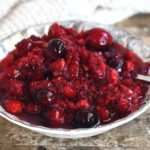Fermented Cranberry Sauce
Fermented cranberry sauce has a bright, fresh flavor that is perfect as part of a heavy holiday meal. This honey-sweetened cranberry sauce is delicious turkey or brie. See the sections above for other serving options as well as long-term storage advice.
- Prep Time: 10 minutes
- Total Time: 10 minutes
- Yield: 2 cups 1x
- Category: Condiment
- Method: Fermented
- Cuisine: Holiday
- Diet: Vegetarian
Ingredients
Units
Scale
- 1 orange
- 12 oz cranberries (3 cups)
- 1/4 to 1/2 cup of raw honey (see the section above for other culturing options)
Instructions
- Zest and juice the orange.
- Wash the cranberries, and remove any that have started to wrinkle.
- Place cranberries, orange juice, and orange zest in a blender.
- Pulse until the cranberries are crushed. It can be thin and smooth or chunky like a relish. I like a roughly chopped mix with some whole berries.
- Scrape the blended cranberries and orange into a glass jar for fermenting. Stir in the honey. Fermenting cranberries will bubble and build up carbonation, so don’t cap with an air-tight lid.
- Ferment in a cool, dark location. It should start to bubble and froth after 24 hours. If you want to ferment it for longer than 24 hours, then stir it once a day to mix the floating cranberry pulp into the ferment. It will become less sweet the longer it ferments, so I generally only ferment for one week.
- Cap with an air-tight lid and store in the refrigerator. See the section above for long-term storage advice.
- Depending on how much honey you use, and how much juice you get out of the orange, your sauce may have too much liquid. Simply strain off the excess liquid before serving. The extra liquid is delicious mixed with sparkling water for a cranberry-flavored drink!
Notes
- Because of the health risks associated with the consumption of raw honey, this ferment is not recommended for pregnant women, children under the age of 1 year, or anyone who may be immunocompromised.
- This ferment relies on the natural yeasts and bacteria in honey. Be sure to use honey that is labeled raw or unpasteurized.
- See the section above for details on using fermented beverages rather than raw honey in this recipe.
